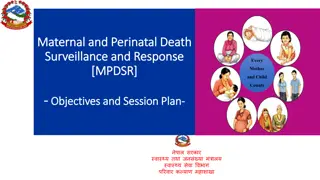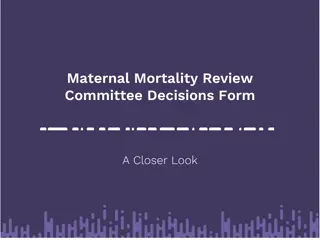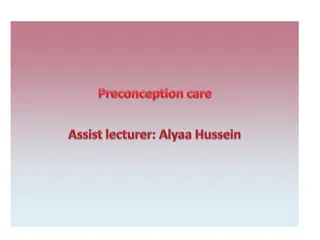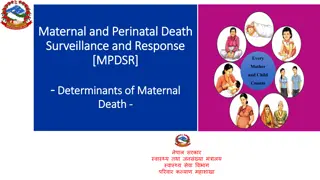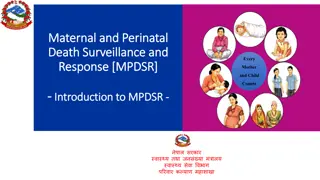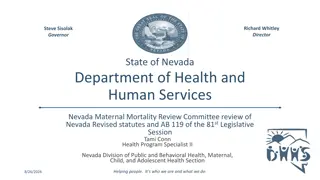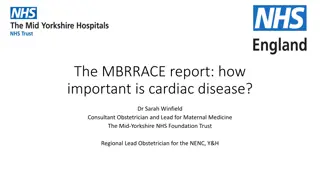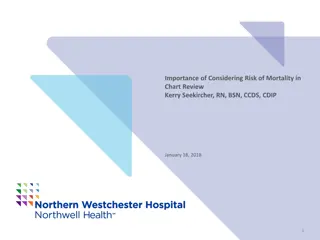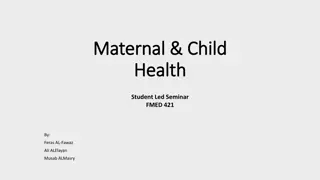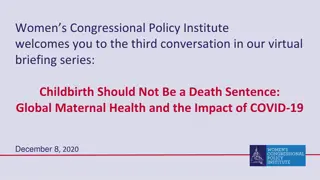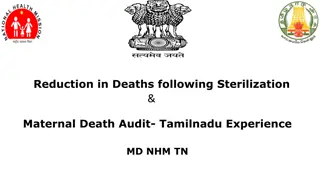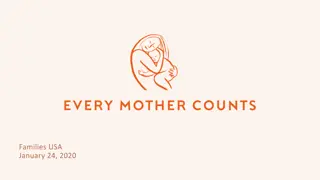Addressing Maternal Mortality Crisis in the US: Key Challenges and Solutions
Maternal mortality remains a critical issue in the US, with rates higher than other high-income nations. Over the past 30 years, pregnancy-related deaths have nearly tripled. The focus needs to shift towards system-wide solutions targeting root causes such as racial inequities, fragmented coverage, lack of providers, and postpartum care. Understanding the key drivers and implementing comprehensive strategies are crucial to reducing avoidable maternal deaths.
Download Presentation

Please find below an Image/Link to download the presentation.
The content on the website is provided AS IS for your information and personal use only. It may not be sold, licensed, or shared on other websites without obtaining consent from the author.If you encounter any issues during the download, it is possible that the publisher has removed the file from their server.
You are allowed to download the files provided on this website for personal or commercial use, subject to the condition that they are used lawfully. All files are the property of their respective owners.
The content on the website is provided AS IS for your information and personal use only. It may not be sold, licensed, or shared on other websites without obtaining consent from the author.
E N D
Presentation Transcript
Our Maternal Mortality Is a Solvable Problem
US maternal mortality is higher than Double That of Other High-Income Nations 17.4 Maternal deaths per 100,000 live births 8.7 8.6 6.5 4.8 4.6 4.3 3.2 3 1.8 1.7 NZ NOR NET GER SWE SWI AUS UK CAN FRA US Maternal mortality: Death while pregnant or within 42 days of the end of pregnancy, irrespective of the duration and site of the pregnancy, from any cause related to or aggravated by the pregnancy or its management, but not from accidental or incidental causes. Used by the World Health Organization (WHO) in international comparisons. Data from 2018 (2017 for Switzerland and UK; 2016 for NZ; 2012 for France) https://www.commonwealthfund.org/publications/issue-briefs/2020/nov/maternal-mortality-maternity-care-us-compared-10-countries Accessed Aug 13, 2021
Over the past 30 years in the US, Pregnancy-Related Deaths Have Nearly Tripled Pregnancy- related deaths per 100,000 live births 2019: 20.1 1987: 7.2 1987 1992 1997 2002 2007 2012 2017 Pregnancy-related death: Death during pregnancy or within one year of the end of pregnancy from a pregnancy complication, a chain of events initiated by pregnancy, or the aggravation of an unrelated condition by the physiologic effects of pregnancy. This CDC measure is used in the U.S. only. https://www.cdc.gov/reproductivehealth/maternal-mortality/pregnancy-mortality-surveillance-system.htm https://stacks.cdc.gov/view/cdc/103855 Accessed Aug 13, 2021
Typical guidance focuses on individuals, not systems CDC: Two Out of Every Three Maternal Deaths Are Preventable Healthy diet Healthy weight Healthy lifestyle Physically active This guidance is difficult without good access to healthcare. We need system-wide solutions targeting root causes. Quit all substance abuse Prevent injuries Address health problems Pre- conception healthcare Plan for potential problems Ensure early prenatal care https://www.cdc.gov/reproductivehealth/maternal-mortality/erase-mm/mmr-data-brief.html Accessed Aug. 22, 2021
To really reduce avoidable maternal deaths, We Need to Understand the Key Drivers Racial Inequities Fragmented Coverage Maternal Mortality Lack of Providers Lack of Postpartum Care
Americas maternal health crisis is Compounded by Racial Inequities 44 Maternal deaths per 100,000 live births, 2019 28.3 20.1 17.9 12.6 Total Black Native American White Hispanic Native Americans herein refers to those described as American Indian and Alaskan Native in 2017 CDC data https://www.cdc.gov/reproductivehealth/maternal-mortality/pregnancy-mortality-surveillance-system.htm https://www.cdc.gov/nchs/data/hestat/maternal-mortality-2021/maternal-mortality-2021.htm Accessed Aug 13, 2021
Americas maternal health crisis is Compounded by Racial Inequities 20% 20% Late or no prenatal care, 2018 15% 13% 10% 10% 8% 5% 5% 4% 0% White Asian Hispanic Black AIAN NHOPI AIAN = American Indians and Alaskan Natives NHOPI = Native Hawaiians and Other Pacific Islanders https://www.kff.org/report-section/racial-disparities-in-maternal-and-infant-health-an-overview-issue-brief/; Accessed Aug 20, 2021
Americas maternal health crisis is Compounded by Racial Inequities 10.8 9.4 Infant Mortality per 1,000 live births, 2018 8.2 4.9 4.6 3.6 Asian White Hispanic AIAN NHOPI Black AIAN = American Indians and Alaskan Natives NHOPI = Native Hawaiians and Other Pacific Islanders https://www.cdc.gov/reproductivehealth/maternalinfanthealth/infantmortality.htm Accessed Aug 20, 2021
The advantages otherwise accruing from education Fail to Overcome Racial Inequities Black college grads vs white college grads 5.2times more likely to die related to pregnancy Black college grads vs whites without high school degree 1.6times more likely to die related to pregnancy https://www.cdc.gov/mmwr/volumes/68/wr/mm6835a3.htm Accessed Aug. 16., 2021
Medicare for All will reduce pregnancy-related mortality by Helping Address Racial Inequities Provide the equitable and universal coverage that is proven to improve outcomes for people of color Invest significant resources in underserved communities Provide training and education for health professionals to combat racial bias Establish a new Office of Health Equity to fund research and data collection on racial inequity, track outcomes, and promote primary care for underserved populations
To really reduce avoidable maternal deaths, We Need to Understand the Key Drivers Racial Inequities Fragmented Coverage Maternal Mortality Lack of Providers Lack of Postpartum Care
ACA mandated coverage for Ten Essential Benefits including Pregnancy, Maternity, and Newborn Care Included in this ACA requirement Excluded from this ACA requirement Individual marketplace plans Small-group plans Employers with >50 workers Self-insured companies Short-term plans Association health plans Some student health plans Young adults covered on parent s plan
Chronic health conditions are Increasing the Hazards of Pregnancy Urban Rural 42% 32% 25% 25% 25% 18% 23% 16% 19% 16% 11% 11% 13% 9% 10% 9% Asthma High Blood Pressure Substance Abuse Diabetes Asthma High Blood Pressure Substance Abuse Diabetes 2005-2006 2013-2014 Admon LK, Winkelman TNA, Moniz MH, Davis MM, Heisler M, Dalton VK. Disparities in chronic conditions among women hospitalized for delivery in the United States, 2005 2014. Obstet Gynecol.2017;130(6):1319 1326
Most people without insurance receive No Prenatal Care in Their First Trimester 93.8% 78.6% Started prenatal care in first trimester 49.2% Private Insurance Medicaid Uninsured https://www.macpac.gov/wp-content/uploads/2018/11/Pregnant-Women-and-Medicaid.pdf Insurance status characterized by both prenatal care and delivery Accessed Aug. 20, 2021
Medicaid expansion Slows Down Maternal Mortality 40 Maternal mortality is getting worse more slowly but is still getting worse Maternal Mortality per 100,000 Live Births 35 30 25 Non- Expansion states Expansion states 20 15 2006 2008 2010 2012 2014 2016 https://www.whijournal.com/article/S1049-3867(20)30005-0/fulltext#fig1 Accessed Aug. 20 2021
Medicaid expansion Slows Down Maternal Mortality Before the ACA, Medicaid already covered lower-income pregnancies. States that expanded Medicaid, however, added more prenatal and postpartum coverage. For every 100,000 lives, expansion states had 4 fewer deaths among whites 6 fewer deaths among Hispanics 16 fewer deaths among Blacks https://www.whijournal.com/article/S1049-3867(20)30005-0/fulltext#fig1 Accessed Aug. 20 2021
Medicaid expansion helps, But Not Nearly Enough 51% Postpartum coverage improves family planning and the outcomes of subsequent pregnancies Preconception coverage improves maternal and infant birth outcomes, and prevents unintended pregnancies Even in states that expanded Medicaid, Uninsurance rates Non-Expansion states Expansion states 38% more than one in five mothers wereuninsured either preconception or postpartum 36% 21% 17% 10% Preconception Postpartum Preconception or postpartum 2015-2018 data. Post partum refers to 2-6 months post partum https://www.healthaffairs.org/doi/pdf/10.1377/hlthaff.2020.01678 https://www.macpac.gov/wp-content/uploads/2018/11/Pregnant-Women-and-Medicaid.pdf (MACPAC Nov 2018) Both accessed Aug. 24, 2021
Medicare for All will reduce pregnancy-related mortality by Unifying Our Fragmented System Medicare for All provides wraparound, lifelong coverage for everybody in the US, including preconception, during pregnancy, and postpartum unlike programs based on need or pregnancy status. Medicare for All would allow individuals to manage chronic conditions and prevent unintended pregnancies, improving both health and pregnancy outcomes.
To really reduce avoidable maternal deaths, We Need to Understand the Key Drivers Racial Inequities Fragmented Coverage Maternal Mortality Lack of Providers Lack of Postpartum Care
We have a typical number of OB-GYN physicians But We Have Very Few Midwives CAN 8 4 US 11 4 NETH 10 25 FRA 11 30 SWIZ 22 32 UK 11 43 NZ 8 46 GER 27 30 NOR 12 53 AUS 7 68 SWE 12 66 OB-GYNs per 1,000 live births Midwives per 1,000 live births Note: Primary Care Physicians play a larger role in Canada, France, and New Zealand https://www.commonwealthfund.org/publications/issue-briefs/2020/nov/maternal-mortality-maternity-care-us-compared-10- countries Accessed Aug 21 2021
Between 2004 and 2014, 10% of rural counties Lost Their Hospital-Based OB Services 641 Rural Micropolitan (county population 10,000-50,000) 591 608 Rural Non-Core (county population <10,000) Number of hospitals providing OB services 453 7,000,000 American women of child-bearing age live where there is no or limited access to maternity care 2004 2006 2008 2010 2012 2014 http://rhrc.umn.edu/wp-content/files_mf/1491501904UMRHRCOBclosuresPolicyBrief.pdf https://www.marchofdimes.org/research/maternity-care-deserts-report.aspx Accessed Aug. 20 2021
2.2 million women of childbearing age live in counties with No OB Provider, No Hospital, No Birth Center Maternity care deserts Low access to maternity care Moderate access to maternity care Full access to maternity care 2020 report at https://www.marchofdimes.org/materials/2020-Maternity-Care-Report.pdf Accessed Aug. 21, 2021
The burdens of scarce OB providers are particularly heavy for Low-Income Urban Parents Navigating a few miles in a large city can be just as challenging as driving 90 minutes to the nearest rural provider. It doesn t really help to have a provider five miles away inside most cities.
When An Area Loses OB Services Out-of-hospital births increase Infant mortality rate doubles Preterm births increase https://www.ruralhealthweb.org/NRHA/media/Emerge_NRHA/Advocacy/Policy%20documents/01-16-19-NRHA-Policy- Access-to-Rural-Maternity-Care.pdf Accessed Aug. 21, 2021
Medicare for All will reduce pregnancy-related mortality by Improving Access to OB Care Providers would be attracted into under-served areas by creating an entire nation of people with good health insurance Providers could spend more time in direct patient care (and be happier) because they ll spend farless time dealing with insurance Midwives would become more available Global budgets would protect vulnerable hospitals
To really reduce avoidable maternal deaths, We Need to Understand the Key Drivers Racial Inequities Fragmented Coverage Maternal Mortality Lack of Providers Lack of Postpartum Care
Most of our maternal deaths happen After the Baby Is Born 31% 21% 19% 17% 12% During pregnancy Day of delivery Days 1-6 postpartum Days 7-42 postpartum Days 43-365 postpartum Data 2011-2015 https://www.commonwealthfund.org/publications/issue-briefs/2020/nov/maternal-mortality-maternity-care-us-compared-10-countries Accessed Aug. 21 2021
Most of our maternal deaths happen After the Baby Is Born 4 1 0 World Health Organization recommends at least 4 postpartum visits Birthing parents in US typically have 1 office-based physician visit postpartum 40% of American births have no postpartum visits https://journals.lww.com/greenjournal/Fulltext/2018/05000/ACOG_Committee_Opinion_No__736__Optimizing.42.aspx Accessed Aug. 21 2021
Most other countries provide Universal Postpartum Home Visits Australia Within week 1, typically one to three visits Canada Contacted or visited within 24 48 hours France Starting within 24 hours, one to three visits Germany Daily if needed until day 10, plus 16 visits as needed until 8 weeks Netherlands Daily, starting day 1 and up to day 10; minimum of 4 hours per day New Zealand At least 5 visits over 6 weeks, starting within 48 hours Norway Starting at 24-48 hours (3 days for many low-risk women) Sweden First visit during week 1, then every 1-2 weeks until week 8 Switzerland Daily up to 10 days postpartum UK At least until 10 days postpartum https://www.commonwealthfund.org/publications/issue-briefs/2020/nov/maternal-mortality-maternity-care-us-compared- 10-countries Accessed Aug. 21 2021
Most other countries provide Universal Postpartum Home Visits Australia Within week 1, typically one to three visits Canada Contacted or visited within 24 48 hours France Starting within 24 hours, one to three visits Germany Daily if needed until day 10, plus 16 visits as needed until 8 weeks Netherlands Daily, starting day 1 and up to day 10; minimum of 4 hours per day New Zealand At least 5 visits over 6 weeks, starting within 48 hours Norway Starting at 24-48 hours (3 days for many low-risk women) Sweden First visit during week 1, then every 1-2 weeks until week 8 Switzerland Daily up to 10 days postpartum UK At least until 10 days postpartum US Varies by state Medicaid program and by individual insurer https://www.commonwealthfund.org/publications/issue-briefs/2020/nov/maternal-mortality-maternity-care-us-compared- 10-countries Accessed Aug. 21 2021
Medicare for All will reduce pregnancy-related mortality by Covering All Postpartum Care Postpartum care would be universally available (as would the rest of healthcare) No insurance company would be able to get in the way of necessary care Every other country has determined that postpartum care is a worthwhile investment in the health of their nation
Medicare for All is the single solution that addresses the Root Causes of the Maternal Mortality Crisis Today s problems Equitable universal coverage, track disparate outcomes, and promote care for today s underserved inequities Chronic conditions managed over a lifetime, not only during pregnancy. No copays, no deductibles, just healthcare. Just. coverage Medicare for All s solutions Racial Fragmented Universal coverage draws providers into underserved areas; Global budgets protect rural hospitals. Lack of providers Reliably covered for everybody, regardless of race, ethnicity, income, or geography. Rural, urban, everybody. Lack of post- partum care
Motherhood should not be deadly. Band-aid approaches won t solve this. It s time for Medicare for All.
Physicians for National Health Program Non-profit, non-partisan, member-supported 501(c)3 Membership open to everyone www.PNHP.org @PNHP Facebook.com/DoctorsForSinglePayer




